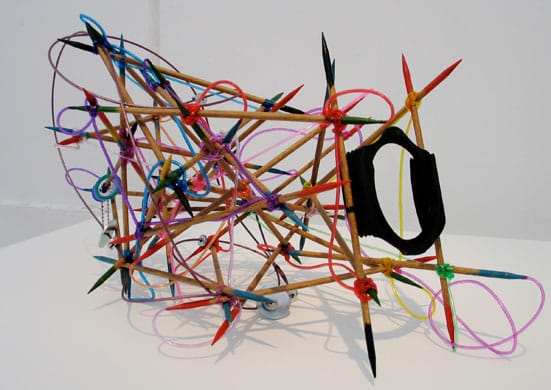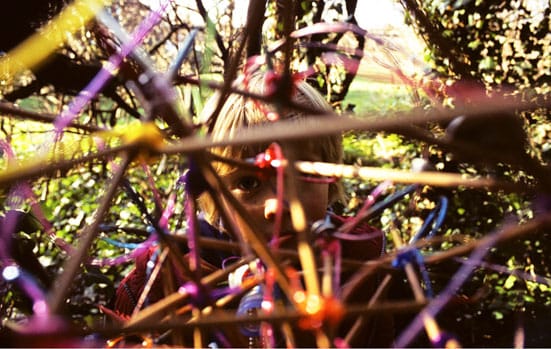There seems to be a watercolour- or driftwood-peddling gallery around every corner. Another artist's studio open to the public, doubling as an insight into the artist's practice and a stall for them to sell their wares. St. Ives trades quite unashamedly on that small chunk of their history in the first half of the twentieth century, when the guiding lights of contemporary British art descended upon its narrow streets seeking an escape from the tawdry London market upon the crests of the Cornish waves. Perhaps when the first of their number arrived, St. Ives was a bustling fishing port, thrilling to the smell of brine and pipe smoke, and the sound of the crashing waves, squeezeboxes and the talk of smuggling. Perhaps it was once a real coastal idyll, unsullied by the twin evils of tourism and heritage – anachronistic in its almost complete reliance on industry, authentic in its participation in natural drama. It must have been different. St. Ives today trades upon this mythical past, as so many places do, without being burdened by the weight of irony implicit in that action. The art on display in the galleries is easily slotted into a class of touristic souvenir, a weird reminder of something you never saw – a fishing boat chugging into harbour, low in the water with the weight of the catch, in front of a setting sun; a white-crested seascape painted in impasto on to a bleached driftwood plank. The economy of St. Ives is completely tourist orientated, but that's not surprising. Nor should it be admonished – it just feels a little vacant.
*
At the top of the hill is The Tate and, when we arrive, it's a welcome relief: glimpsing the familiar branding is like a deep drag on a cigarette – slaking some cavernous addiction. We welcome it with open arms, blissfully skipping over the carcinogenic warnings. Immediately however, the veneer appears to be warped and split. Literally: paint flakes and metal rusts, and guano splatters every place out of reach of lazy mops. I suppose it’s quite in keeping with the context; most buildings are in a state of deterioration, feebly fighting a losing battle with a nature that seeks to reclaim its shore line – at some places visibly having wolfed down great chunks of chalky cliff. The briny air, acidic gull-shit and lashing rains take their toll – the outside of Tate St. Ives is showing its age. Though the fact that no-one has managed to fully exert control of the exterior of the institution is comforting – it looks quite at home.
We've come here to see Adam Chodzko's retrospective exhibition and are pretty excited. For some reason, he doesn't seem to have fully-fledged representation in the UK (as opposed to Italy and the USA, for example, where he does have gallery representation – though I may be wrong), and consequently it's quite hard to see his work – particularly in any numbers. This is, I've always thought, a shame, not least because his work – more so than almost any other artist's that I can think of – functions at its best cumulatively. The luxury of any sort of overview is, therefore, exciting.
In the first room, 'Heron Mall' (named after Patrick Heron, who designed the slightly lurid stained-glass window on its east wall), the walls, shelves and mezzanine are hung with a jumble of outdoor clothing. Specifically, these clothes are all cold-weather-wear – unused since the summer arrived – and have been donated by local residents. They include some unrecognisable swathes of cloth that must be something like stable-rugs for horses; huge, cloth-lined waders; worrying patches of survival-wear – local and industry-specific items – along with mittens, fur coats, bobble-hats and duffle coats. They're organised into categories and stored – displayed – according to a pattern somehow wrung from the Heron window. An unfinished looking legend is pinned to the wall. 'Borrowed Cold Lodge' (the name of the new, site-specific work) feels dormant in the sense of hibernation: asleep in thick, warm fur, awaiting its time to become practicable again, to have purpose. These clothes, like so many of the props in Chodzko's work, have the appearance of dreck, of the unloved; but are actually merely awaiting their purpose to be rediscovered and slotted into some overarching, previously inconceivable plan. One of Chodzko's many alchemical roles is surely as a diviner of this hidden purpose – in this instance the clothes become art and, at the same time, are stored effectively 'til the end of the show: Autumn, when the clothes will regain their motive. Running a hand over the heavy, musty coats on one rail – dappled in pink and yellow light from the stained-glass window – one feels uniquely in limbo, both spatially (reminded fiercely of the outside, yet in a cloakroom before the main galleries; in muted exhibition-space) and conceptually, between purpose and aesthetic.
The second upper gallery is a semi-circular corridor with a terrific view of the coast outside and the sea beyond. The display case that lines its side is filled with the documentations and byproducts of several of Chodzko's works. 'Design for a Carnival' is a sprawling set of pieces that, together, form the preliminary proposal for a new kind of carnival; one filled with extreme particularities (the music for Float 17 as it pauses, briefly, under a flyover) and apparently unlimited possibilities (ants 'selecting' the design of the sequins). This is a carnival of global context, determinedly avoiding the globally homogeneous by including, possibly, everybody and everything. The intersecting of nature, technology and the particularities of carnivals in the wooden record sleeves and 'mask filters' (camera-lens filters made of porcupine quills, cable-ties, beads and feathers) points towards the invention of something extraordinary – less carnival more society; less a singular event and more a means of interpreting everything. Like the images that the mask filters provide (photos bordered and cross-hatched with blurred, too-close scrap), the work here provides a filter through which to view the world. Most importantly, perhaps, is the fact that this carnival and its infinite committee are imaginary – impossible. This is not to imply a failure, but to underscore its vivid resistance to the constraints of social and political boundaries.
The film 'Plan for a Spell' is a collection of videos of parochial, folk-like practices, narrated with conversational, opaque subtitles. Each element – the video, sound and subtitles – are encoded in such a way as to create a constantly changing, random whole. The ‘spell’ of the title is, it seems, lost. The ingredients are known – the footage, the words, and the sound – but their particular, magical arrangement is not, and the only way to find the correct constellation is to try them out in all of their vast numbers of permutations. Shaky analogue footage of the Ottery St Mary Tar Barreling is calmly declared ‘more like it’, its potential usage discussed with abstracted indecision. The wind howls. What the spell might do if finally and properly incanted is unknown and, presumably, subjective – or it might only ever be played out to a vacant gallery, conjuring nothing. The process of deciding upon the ‘success’ of the spell is coyly analogised to that of the artwork, with the artist relinquishing control of the work to a series of autonomous systems: the random encoding of the elements of the DVD; the looping of the film denying an end to the spell; the audience’s response to the work being, ostensibly, the effect of the spell. The pluralistic voice of the subtitles is another committee, in ignorant cahoots with the audience, attempting to ascribe purpose; to decipher meaning. Similarly to ‘Design for a Carnival’, the work becomes a means of uniting peoples and processes into democratically initiated purpose. This purpose is unknowable at its end (it may not have an end) but is deliberate and, in the case of the carnival, grand in its proposal. The result is deftly political – carefully uncommitted to partisanship or polemic, Chodzko provides the opportunity, facilitates the exchange. Dissimilarly to other artists however, Chodzko promotes the fantasy of the context, and it is the imaginations of his actual and potential participants that he stimulates, rather than their recreation of a version of ‘reality’, replete with its divisive hierarchies and demographics. When he invites stammerers to describe a fire, it is neither for the bald titillation of an eventual audience (the work exists solely as a series of posters) nor to provide a podium for the stammerer’s plight. The posters that advertise the next meeting to be in the lobby of the local hotel are not appealing to sycophantic, aspiring members; nor are they excluding the involvement of any particular audience. These events might never have happened - missing, as they are, crucial information regarding location or date, time or even purpose. They are signposts of activity, potential and imaginary, that might be undertaken in their wake; initiatory rites that induct you, if you are willing, into a way of thinking that distorts everyday reiterative norms through fantastical application.
A small-ad in loot is circled in red and reads: ‘Series of 4 drawings of tiny princes in battle, large pastel drawing of earlier computer, 2 small oil paintings of red clouds, slightly scratched, 6 lithographic prints of utopian canal systems, 1 beautiful pencil sketch of thighs, 1 small clay figurine on dying girl soldier, unglazed, £150 ono the lot.’
*
Leaving The Tate, our synapses snapping gleefully, St. Ives is a more distinct, more poised place. Its future is writ huge like unintelligible Braille on its eroded streets, and we walk back to the harbour.
Much love,
Ed Atkins

Adam Chodzko 'Mask Filter' 2007. Mixed Media. Approx. 23 x 26 x 40cm (c) The Artist

Adam Chodzko 'Pattern for a Procession with Two Masks' 2007. 81 x 35mm slide carousel projection. 4 minutes (c) The Artist